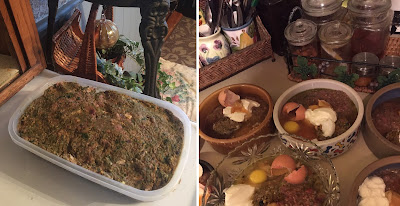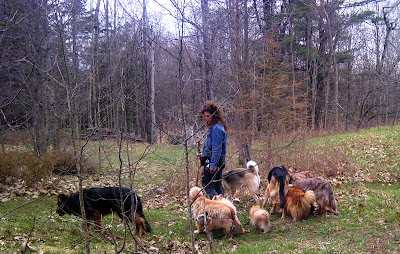Dog Anxiety – Anxious Pacing, Hyper Activity - How to Stop It
Anxious pacing, hyper activity – does your dog exhibit these
behaviours? Maybe you have tried, or still are trying to tire your dog out with
exercise - taking your dog for several long walks every day, play time with
doggie friends, agility, fly ball and more. Even with all of this activity,
nothing seems to tire your dog. You walk in the door, unclip the leash and your
dog flies into the house, bounds off the furniture, and does not ‘settle
down’. Your dog might ‘ask’ to go back
out, after he/she has just come in. You go to get ready to take your dog for
his/her third walk of the day – your dog is pacing, jumping, whining. Or, maybe
after a long day you finally get to sit down and relax – you’re about to read a
book, watch a movie, or a program on television… and your dog will not settle
down. Your dog gets up and starts to pace, or goes to look for something to
‘get into’, your dog brings you a ball, drops the ball in your lap, and begins
to bark to tell you to ‘throw it’. You
have guests come over, or your children invite friends over – your dog is
everywhere, dashing about, barking, pacing. You are exasperated – you’ve tried
everything, yet nothing slows or settles your dog’s pacing – hyper activity.
Anxious Pacing - Why Does Your Dog Do This?
Well for a start your dog may have heightened sensitivity – an attribute that, when understood can be an amazing
asset, but when misunderstood leads to no end of trouble for you, and your
dog. Anxiety, and stress may be
compounded by other contributing factors, for example...
- You have heightened sensitivity.
- You and/or your dog has experienced an acute or chronic trauma.
- Your dog’s diet is not able to properly support his/her well being, etc.
The confluence of these circumstances can create a bad stress response in your dog, and you too!
The Daily Toll On You and Your Dog can Cause Long-Term
Damage
Chronic stress is an inflammatory condition which can make
your dog more vulnerable to inflammatory disease, degrade the quality of daily
life, and shorten life-span. Stress has the same effect on us humans.
Your
Dog's Anxiety -Could it be a Gift, or Is It Just a Burden?
Dogs
offer us humans many gifts - companionship, empathy, love, loyalty, joy and the
opportunity to expand our humanity. If you adopt a dog that has acquired-anxiety,
you will see further below that in order to help the dog, you must first help
yourself - the rescue dog helps you, before you can help him/her.
If
you have had a dog since he/she was a puppy, and your dog develops anxiety, you
may not realize it during the developmental phase of the condition but it is
likely you have inadvertently contributed to the anxious state of your dog. To
heal your dog of anxiety, you must first examine your own state of being, and
you may need to do some healing. If it were not for your dog - the impetus to
heal yourself may never have presented itself - your dog has given you a gift
of immense value. Granted at the this time you may simple feel as if you have
an immense burden - read on below, as when you do you will find the tools you
need to unlock your dog's gift, and in so doing find healing for both you and
your dog...
Anxious Pacing, Hyper Activity - Why is Your Dog
experiencing this State?
Simply put – your dog does not know how to ‘self-regulate’-
turn herself off, relax, and settle down. Heightened sensitivity if not
properly supported can cause over-stimulation. Too much exercise can serve to
over-stimulate your dog. Over excitement leads to over-stimulation. Not knowing
how to confidently, normally cope with the ins and outs of daily life
situations causes anxiety. Your dog’s concept of ‘normal’ is being in an
excited state.
Three Types of Energy – Only two of Which Can be Expended
with Exercise
I always say there are three types of physical energy that a
dog may have to expend…
Energy Type 1
- Daily quota of normal physical energy that is typically expended via normal exercise such as going for daily walks.
Energy Type 2
- Stored-up energy which occurs of a dog is not getting the opportunity to expend daily energy on a regular basis.
Energy Type 3
- This energy is created by an unbalanced psychological state which creates physical energy.
- Think about how you feel when you are agitated
- You may have trouble sitting still, you may have difficulty concentrating, you may get up and pace, you may feel the need to otherwise expend energy, but if you are unable to resolve the real source of your stress, you will not be able to relax - even if you are exhausted.
- It is the same for our canine companions.
- To resolve the anxious pacing and hyper activity you must address the root cause – anxiety, and stress.
So let’s take a look at how to remedy this curable
situation…
How To Stop Anxious Pacing, Hyper Activity
Your dog needs you to take over decision making – you must show
your dog what he/she must do, you must show your dog what 'normal' really is.
Once you have properly mentored your dog, he/she will settle down – he/she will
know how maintain a good stress response; that in turn provides the ground work for self-regulation.
Before you can start to teach your dog self-regulation, remember that you need
to learn how to self-regulate yourself.
For the purposes of this exercise we will use the example of
a dog that starts to pace at night just when his/her human has sat down to
relax…
When night time rolls around, you are going to have to take
over for your dog – you cannot leave any decision making up to your dog until
he/she has learned how to cope. Meaning, he/she has had the opportunity to
learn what he/she should do.
So, when you go to sit down to relax, and your dog starts to
get agitated (likely exemplified by pacing back and forth, getting into ‘stuff’
etc.) do the following...
- Stop the pacing.
- When you sit down – indicate to him/her that he/she is to sit down.
- Assign a place for your dog to sit.
- Do not allow him/her to get up, and move elsewhere.
- You decide where he/she sits – you don’t allow your dog to decide.
- Your dog will try to get up – don’t be agitated by this, simply show your dog to sit back down.
- Open your senses, be observant but not intense - use your periphery vision, and hearing:
- Notice if your dog starts to pant.
- If your dog’s breathing escalates to panting, take a deep breath to ground yourself.
- If your dog starts to get up...
- Give your dog an audio cue like ‘Uh’
- Follow that immediately with a visual cue – put your hand in the air in-front of you with palm facing vertically up (stop symbol), and then turn your palm so it is facing up to indicate to him/her to sit back down, then sweep your palm in a downward motion to show him/her to lay down.
- When you first do this exercise, your dog may ignore your breath, your vocal cue, and your hand signals but do them anyway to give him/her the grace of choice to choose to respond.
- If he/she decides to ignore your cues, and instructions, and she gets up – you get up too, then calmly walk over to where he/she has gone...
- If he/she is pacing, take another deep breath, and then;
- Put the following thoughts in your min;
- “I am not upset at you, you simply need direction, no more pacing and anxiety, I have your back – this is what we are going to do”
- Then lightly but firmly do one of the following:
- ‘Still’ (stop) his/her pacing by touching his/her side with your fingers outstretched, sustain the touch, still yourself – this is what I call a ‘stilling touch’.
- Hold the touch for at least 5 seconds, after which you can take your other hand – draw two fingers up from his/her eyes to sweep outward towards where you would like your dog to go.
- If he/she does not respond to this by going to the place you have indicated, lightly grasp his/her collar (no tension in your hand, no force, just lightly). With two fingers on one side of the collar, and your thumb on the underside of the collar give his/her collar a quick little plucking motion in the direction you want him/her to go in.
- Don’t pull hard, and don’t do a sustained tug/pull for if you do you are indulging in an argument when what you really need to do is direct with respect.
- You do not want to force, or argue – you simply want to show what it is you want.
- If he/she tries to wander off – simply take a deep breath, say ‘uh’ (audio cues to get his/her attention, and let him/her know you are directing).
- Walk calmly (normally) up to your dog, give him/her a quick tap on her side (do not linger the touch, do not push), then show him/her with your hand where you want your dog to go.
- If he/she decides not to go, take her lightly by the collar and give a slight pluck of the collar in the direction you want him/her to go, then immediately relax your grip on the collar, and let go of the collar completely.
- Use your hand to indicate to him/her to lie down.
- Then you go sit down, take another deep breath as you do. Use your thoughts to help ground you through the entire process – i.e. “this is your new normal, I have your back, I will direct you so you don’t have to be anxious – I will let you know what to do”
Before you start the above exercise remember you want
your dog to calm; what you want from your dog – you must first be yourself.
This is the true meaning of consistency, which in-turn is a fundamental quality
of leadership.
By doing the above you take 100% control of the situation…
- You put a structure in place, which is safe and comforting for your dog.
- In the process of doing the above, you work with your dog, your dog works with you - you create a situation of mutual respect. Your dog gets to work psychologically which is stabilizing, and fulfilling for your dog.
- You maintain control of yourself first – you remain calm, grounded – which is what you want your dog to be.
- You lead by true example – something dogs, (and humans) appreciate. A skill that will serve you well in many aspects of your life...
- Your dog's gift to you is realized.
Continue to do the above – don’t allow yourself to get
sucked into the emotion of your dog’s anxious state. Remember your dog will try
to return to his/her anxious state because she thinks that is normal. Just like
we would do all we can to adhere to what we think of as normal – even if that
‘normal’ is an altered, and unhealthy state of normal. Sometimes we need someone else to help us
remember or learn what normal is
Guide your dog with true logic and he/she will embrace it.
Wander off course yourself by becoming unstable (emotional), and you lead your
dog to be unstable.
Every time your dog tries to get up, give him/her the cues
so eventually he/she won’t bother to ‘go there’. Adhere the true meaning of consistent.
By doing the above you teach your dog how to embrace calm.
This builds his/her confidence, helps to dispel his/her chronic anxiety, and
eventually your dog will be in a position to make good choices without constant
supervision from you.
Never let your dog pace. Pacing is anxiety, and the more
he/she paces, the further he/she will escalate into a state of anxiety. You can
use the above technique in all situations in which your dog becomes agitated.
The more situations you apply this to, the faster you and your dog will learn
to remain calm. Every situation in a typical day influences the next situation
– use this to your advantage. And remember do as I do, be as I am – whatever
you want your dog to do – you must first achieve that state yourself.
Holistic Diet, Nutrition, Wellness Services Tailored to Your Individual Dog and Cat
For information about my holistic diet, nutrition, wellness services visit my:
Maintain good health | Address acute and chronic health issues | Pre and post surgery support and recovery
My holistic wellness services are available worldwide via video consultation.
🌎 USA | Canada | UK | Europe | Australia | New Zealand | Asia | South and Central America | Africa | UAE
📱 FaceTime | Facebook | Skype | WhatsApp
Holistic Behavioral Services For Your Dog
For information about my holistic behavioral services visit my:
For dogs of all ages, sizes and breeds
My holistic behavioral services are available locally in-person and worldwide via video session.
🌎 USA | Canada | UK | Europe | Australia | New Zealand | Asia | South and Central America | Africa | UAE
📱 FaceTime | Facebook | Skype | WhatsApp
Affiliations to Companies
✓ None.
✓ I don't sell food or supplements.
✓ I'm not aligned with any companies.
✓ None.
✓ I don't sell food or supplements.
✓ I'm not aligned with any companies.
Article and graphics by Karen Rosenfeld











